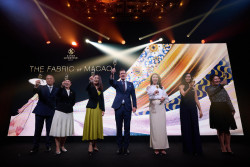
Originally published on metropolis.co.jp on August 2012

Supporters of Korean pop music have been trumpeting the arrival of hallyu, or the “Korean wave” of music, as a major world force for a number of years. There is no doubt that, with number-one singles and hot albums from superstars like Girls’ Generation, Kara and 2NE1, the global K-pop phenomenon is very present in Japan. But will K-pop break in the mainstream US, as writer Charles Ayres suggested in this column a few months ago [“The Last Word,” Feb 17]—the biggest and most influential music market in the world?
It’s not for lack of trying. Korean music management giant SM Entertainment produced “SM Town” at Madison Square Garden in October 2011 with an array of acts from its roster, including Girls’ Generation. This was a very rare showcase for K-pop at such a famous venue, and the company claimed the show was sold out. But despite it being a one-night-only special event, music insiders were aware of ticket giveaways. US-based Nicole Lent, who writes about Asian music, attended and said she saw, “a fair amount of empty seats.” Simply put, the show didn’t sell out despite the all-star line-up of the most powerful music company in Korea.
LA-based K-pop expert Alice Han, previously a consultant for SM in the US, notes that major US media and sponsors don’t have confidence in the genre. “The majority of press outlets focus on what’s trending here in the US, so it’s a bit of a challenge for Korean acts unless they are directly tied in with a popular US act. And, the majority of mainstream sponsors still believe K-pop falls under a niche market, therefore, they’re hesitant to bring a multi-million dollar budget.”
Nevertheless, there is no doubt that K-pop is making some progress in the States. For example, Jay Park (born Park Jae Beom) has found success with his 2012 New Breed album, which peaked at #4 on the Billboard World Albums chart. In addition, Girl’s Generation maxi-single “Boys” held an impressive #5 spot on the Heatseekers chart.
But in reality, sales for these two releases are meager. It’s possible to estimate New Breed’s total sales (digital and physical) at less than 4,000 units, and that of “Boys” as less than 9,000. Absurdly low considering these are the cream of the K-crop in the US so far this year. The figure for Girls’ Generation is even more shocking when you realize they accompanied the song’s release with a performance on The Late Show with David Letterman.
When you look at cold, hard sales figures, the claim of success for K-pop in the US does not stand up in the least. And remember, in the music industry, more than in other businesses, “money talks and bullshit walks.”
Another overhyped point is that Korean artists are outclassing Japanese artists in the US. While it is clearly true that K-pop has received more attention in the US than J-pop recently, the situation of the two industries is so wildly different it makes the comparison moot. According to the International Federation of the Phonographic Industry (IFPI), Japan is the second biggest music industry in the world, narrowly behind the US. In 2011 it did about $3 billion in physical (mainly CD) sales. That’s basically on par with the US. The intensely lucrative nature of the Japanese market—and the fact 84 percent of it is domestic (according the latest figures from the Record Industry Association of Japan)—make it almost ridiculous for a popular Japanese star to drop everything to try and break through in the US.
The situation is the opposite in Korea. Bernie Cho, president of DFSB Kollective, a Seoul-based music-marketing agency that was one of the first to make K-pop available internationally, notes, “Korean artists have no choice but to break out overseas, it’s not just a creative necessity, it’s a financial necessity because the Korean market is so small.”
Clearly, it’s absurd to compare the exports of Japanese and Korean music when one has a tremendous incentive to stay at home while the other has a tremendous incentive to go abroad.
In addition to this, the numbers are not actually in Korean artists’ favor when compared to (basically) the only Japanese artist who has seriously tried to break in the US inthe last few years. Hikaru Utada made her second attempt at US success with her album This Is The One in 2009. Though many considered it a failure, it did grab the top position on the Heatseekers chart in May and rose to #71 on the overall Billboard albums chart (the Heatseekers chart is just for new artists). Billboard reported the album sold about 56,000 copies. Not very good, but better than any K-pop artist has done this year.
The upshot is, despite the hype for K-pop (and a lot of YouTube hits), the idea that it’s any kind of market force at all in the US is fallacious. If and when K-pop does break through to challenge the likes of Lady Gaga, Rihanna, Nicky Minaj or Bruce Springsteen, there will indeed be a seismic cultural shift—but it hasn’t happened yet.







